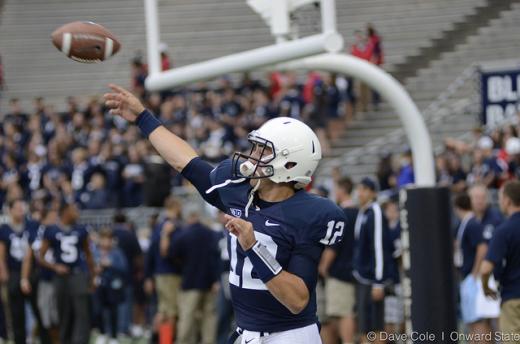Time to forget that Jake … er, ah … Waterschamacallit.
As Cher said in Moonstruck, “Get over it.”
Instead, try to figure out — as he no doubt is 24/7 — what Bill O’Brien can do about the quandary of a bench at quarterback that is anything but deep.
While Brady is Brady in New England no matter who is his coach, the true measure of a man – in this case, our man O’Brien – is Thaddeus Lewis. And George Godsey and A.J. Suggs. And yes, Matt McGloin.
So now that the kid from Iowa’s version of “Community” is done chevychasing Penn State away, lest we forget that in this instance, the Bill with the goods is still the Nittany Lions’ head coach. His Patriots’ system is based as much as mind and soul and as it is body – at least when it comes to quarterback. If otherwise, Paul Jones would be the starter today. Backed-up by Rob Bolden.
Still, nearly a six-pack of top tight ends remains. As do Steven Bench, a sophomore-to-be. And Christian Hackenberg, a Nittany-Lion-to-be. One problem is that Bench has two games and a 2-of-8 collegiate passing experience. Another is that Hackenberg has yet to officially sign.
A third problem is that when Hackenberg does, he won’t be able to practice until the start of preseason drills in August. A fourth is that the plan reportedly was for him to redshirt, saving him for when the Nittany Lions are finally bowl- and Big Ten title-eligible. Fifth is that Penn State is lacking a true backup quarterback for spring drills (now that Garrett Venuto, seemingly age 28, will have finally graduated – although he does hold one more year of eligibility).
And sixth, God forbid – now that He’s not busy, having directed Jake Waters to KState — there’s an injury.
Another JUCO QB is supposedly on the way to Happy Valley, several premium websites are reporting. Still, junior college is not the proving ground that McGloin entered the 2012 season having weathered. In his two Big Ten seasons prior to 2012, MCGloin threw 446 passes. In 2012, he threw 446 passes. That’s seasoning, no matter how you look at, even if the offensive scheme is brand new.
So, whether it’s Jake Waters, Jake Cutler or Muddy Waters, a couple of years of playing – and winning games — against the BCS big boys is worth something.
How did O’Brien get into this mess? Well, under the Paterno Plan, Bolden was supposed to head into the 2013 season with at least one year (maybe two) of eligibility remaining. Same with Jones. But when OB saw that both weren’t the Nittany Lion quarterbacks of the future, he told them so with full presence of mind, and now their Penn State future is behind them – Bolden at LSU, where he’s thrown nary a pass, and Jones, to Robert Morris, after he finishes the fall semester at Penn State next week. His finals really will be final.
There would be even more to worry about if O’Brien’s game plan offense wasn’t flexible, and easily molded to both the opposition and the strengths of his own unit – a la a late-season Zach Zwinak.
O’Brien isn’t a one-Pat pony. He was the offensive coordinator, quarterback coach and assistant head coach at Georgia Tech – before George O’Leary took his doctored-up resume (and O’Brien) to Notre Dame for a five-day stint – and also had the same OC/QB gig under Ted Roof at Duke.
Throw in a year of OTJ training his past year at PSU, and the offense could be A-OK no matter who is behind center. Could be. Because O’Brien’s track record of a smooth transition from Quarterback A to Quarterback B is a mixed bag.
EXHIBIT A: GEORGIA TECH
In 2000, when O’Brien was Georgia Tech’s running backs coach, Yellow Jackets quarterback George Godsey was 222 of 349 (63.6%) for 2,906 yards, with 23 touchdown passes and just six interceptions, for an efficiency rating of 151.86.
In 2001, O’Brien’s first year as O-coordinator and QB coach at Georgia Tech, Godsey was 249 of 384 (64.8%) for 3,085 yards passing, with 18 TDs and 11 interceptions, for an efficiency rating of 142.07. His completions and yards were school records. But overall, that season was on par with 2000.
In 2002, O’Brien’s first transition of quarterbacks came into play. With Godsey gone, the quarterback was A.J. Suggs, a part-time starter at Tennessee before transferring to Georgia Tech. QB production dropped, although not precipitously – but Tech was 7-6 after going 17-8 the previous two seasons. Suggs was 208 of 363 (57.3%) for 2,242 yards, with 12 TDs and 15 interceptions, with a rating of 111.83.
The question is: Will McGloin be Godsey and his successor be Suggs?
EXHIBIT B: DUKE
In 2005, in O’Brien’s first season as offensive coordinator and QB for a horrible Duke squad head-coached by Roof, a two-quarterback rotation of Zack Asack and Mike Schneider failed to reach the numbers Schneider amassed by himself in 2006. The two combined for fewer completions on more attempts, with a lower completion percentage, with fewer touchdowns and twice as many interceptions as Schneider had in 2004.
In 2006, O’Brien made major headway with a new quarterback and first-time starter. As a freshman under O’Brien’s tutelage, Thaddeus Lewis was responsible for a big jump in Duke’s passing game. He completed 180 of 340 passes for 2,134 yards, with 11 TDs and 16 interceptions. By his senior year, Lewis was a candidate for the Davey O’Brien Award after throwing for over 10,000 yards and 56 touchdowns in his college career. O’Brien has to get some credit for laying the groundwork.
The question is: Is there a Lewis in Penn State’s future in 2013?
And we’re not talking Penn State freshman wide receiver Eugene Lewis — who played quarterback in middle school and as a high school frosh — either.
That would be anything but a Very Brady Moment.



